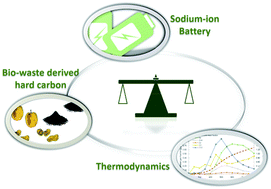当前位置:
X-MOL 学术
›
Green Chem.
›
论文详情
Our official English website, www.x-mol.net, welcomes your
feedback! (Note: you will need to create a separate account there.)
Addressing the energy sustainability of biowaste-derived hard carbon materials for battery electrodes
Green Chemistry ( IF 9.3 ) Pub Date : 2018-02-28 00:00:00 , DOI: 10.1039/c8gc00085a Arianna Baldinelli 1, 2, 3 , Xinwei Dou 4, 5, 6, 7, 8 , Daniel Buchholz 4, 5, 6, 7, 8 , Mario Marinaro 5, 6, 9, 10 , Stefano Passerini 4, 5, 6, 7, 8 , Linda Barelli 1, 2, 3
Green Chemistry ( IF 9.3 ) Pub Date : 2018-02-28 00:00:00 , DOI: 10.1039/c8gc00085a Arianna Baldinelli 1, 2, 3 , Xinwei Dou 4, 5, 6, 7, 8 , Daniel Buchholz 4, 5, 6, 7, 8 , Mario Marinaro 5, 6, 9, 10 , Stefano Passerini 4, 5, 6, 7, 8 , Linda Barelli 1, 2, 3
Affiliation

|
Dealing with the increasing need for battery electrodes materials, renewable and widespread resources – such as bio-derived hard carbon – are under investigation to find a sustainable alternative to state-of-the-art materials, suffering for scarce availability with regard to rising demand. Hence, in a manufacturing scenario governed by the concept of circular-economy, bio-waste derived materials are attracting much interest. Nonetheless, the manufacturing process to transform bio-waste (for instance, hard carbon production via pyrolysis) needs also to be low-energy demanding to achieve overall sustainability. This paper presents a generalized model to account for the energy balance of hard carbon synthesis via bio-waste pyrolysis. In detail, the model provides an evaluation of the pyrolysis heat of reaction, weight reduction and pyrogas yield. Despite the calculation is not considering the exact thermal decomposition kinetic, the model is flexible and easy to implement, showing great usefulness for the energy balance estimation of a process characterized by a huge variability, especially with regard to a primary feedstock like bio-waste. The model is validated against the experimental characterization of depectinised apple pomace-derived hard carbon, which represents a conspicuous bio-waste from the food industry and thereby an excellent candidate for the production of sustainable electrode materials.
中文翻译:

解决用于电池电极的源自生物废物的硬碳材料的能源可持续性
为了应对对电池电极材料的日益增长的需求,正在研究可再生和广泛的资源(例如生物来源的硬碳),以找到可持续发展的替代最新材料的方法,因为需求不断增长,供应稀缺。因此,在受循环经济概念支配的制造场景中,源自生物废物的材料引起了人们的极大兴趣。尽管如此,转化生物废物的制造过程(例如,通过热解法生产硬碳)也需要低能耗,以实现整体可持续性。本文提出了一个通用模型来说明通过以下方法合成硬碳的能量平衡生物废物热解。详细地,该模型提供了反应热解热,重量减轻和热气产率的评估。尽管计算没有考虑确切的热分解动力学,但是该模型灵活且易于实施,对于以巨大变化为特征的过程的能量平衡估算显示出巨大的实用性,尤其是对于像生物废料这样的主要原料而言。该模型已针对脱果胶苹果渣衍生的硬碳的实验特性进行了验证,这代表了食品行业的显着生物废物,因此是可持续电极材料生产的极佳候选者。
更新日期:2018-04-03
中文翻译:

解决用于电池电极的源自生物废物的硬碳材料的能源可持续性
为了应对对电池电极材料的日益增长的需求,正在研究可再生和广泛的资源(例如生物来源的硬碳),以找到可持续发展的替代最新材料的方法,因为需求不断增长,供应稀缺。因此,在受循环经济概念支配的制造场景中,源自生物废物的材料引起了人们的极大兴趣。尽管如此,转化生物废物的制造过程(例如,通过热解法生产硬碳)也需要低能耗,以实现整体可持续性。本文提出了一个通用模型来说明通过以下方法合成硬碳的能量平衡生物废物热解。详细地,该模型提供了反应热解热,重量减轻和热气产率的评估。尽管计算没有考虑确切的热分解动力学,但是该模型灵活且易于实施,对于以巨大变化为特征的过程的能量平衡估算显示出巨大的实用性,尤其是对于像生物废料这样的主要原料而言。该模型已针对脱果胶苹果渣衍生的硬碳的实验特性进行了验证,这代表了食品行业的显着生物废物,因此是可持续电极材料生产的极佳候选者。











































 京公网安备 11010802027423号
京公网安备 11010802027423号